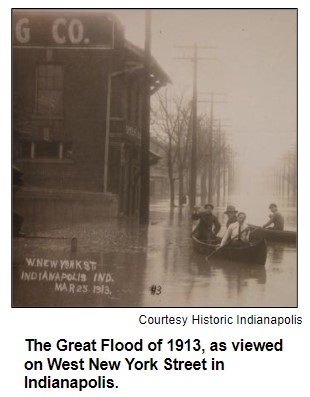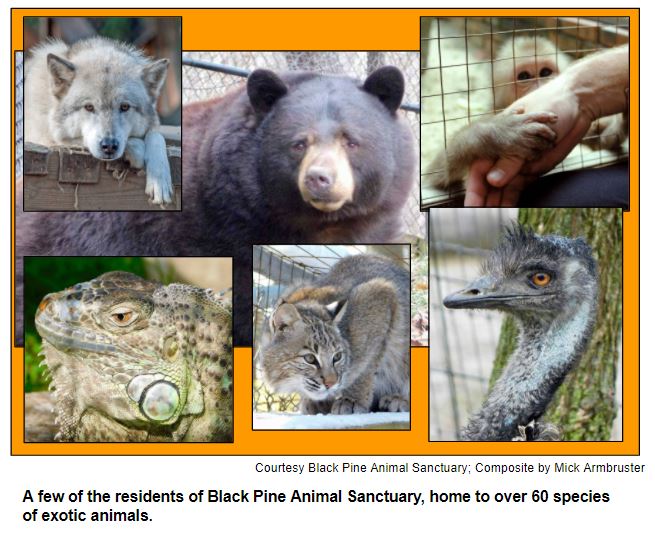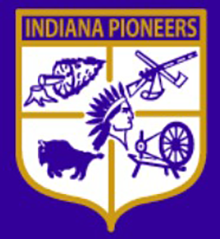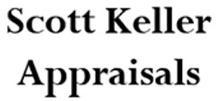Airs Saturdays, noon to 1 p.m. ET on WICR 88.7 FM.
Or stream audio live from anywhere on WICR Online!
April 09, 2022
Bear pit at Riverside Park and other bygone animal attractions: encore

Consisting of a fenced, circular pen with two arched doorways that allowed the bears to enter a sheltered den, the bear pit at Riverside was featured on thousands of postcards that have become collectibles.
And the Riverside bear pit, although the longest-lasting and most significant local animal attraction during the era (it even sometimes was casually referred to as a "zoo"), wasn't the only collection of wildlife on display in Indianapolis parks.
The popularity of the attraction at Riverside led to a public exhibit of bears at Garfield Park beginning in 1905, according to research by attorney Ed Fujawa, who is Nelson's guest on this encore of a show originally broadcast April 17, 2021. Monkeys also were exhibited for a few years at Garfield Park - as well as, even more briefly, at Brookside Park, where visitors also could gaze at exotic birds.

The animal attractions at Riverside - which even included deer, elk, wolves and (briefly) two sea lions - and at the other parks long predate what is considered to be the first official Indianapolis Zoo. It opened in 1964 in Washington Park with a collection of about 500 animals, according to the Encyclopedia of Indianapolis. The zoo at Washington Park closed in 1987, with a spectacular reopening later that year of the zoo at its current site in White River State Park.
Of the bygone Riverside Park bear pit, Ed Fujawa writes: "While the bears and other animals were popular with visitors, the conditions in which the animals were kept were not ideal." He describes letters of complaint in 1900 to Indianapolis newspapers.
Ed elaborates on the poor treatment of park animals at the time, calling them "disgraceful, especially when compared to modern standards. The animal pens were too small, especially for the bears, and the staff of the parks often did not take action to protect the animals from outside influences, such as visitors to the park, or natural disasters."
His blog post recounts floods of the nearby White River that resulted in "close calls" for the bears, who "climbed trees and logs placed in the pit to escape the encroaching water."
According to Ed, a female bear at Garfield Park named Minnie died in 1905 after being fed buckeyes by the public. Local newspapers speculated that buckeyes were poisonous to the bear.
 With his Class 900 blog, Ed focuses on unearthing Indy history that's often been overlooked or forgotten. In 2020, he was a Hoosier History Live guest for a show about tree-planting crusades in Indy that began in the 1850s. Even then, city residents were worried about the loss of tree canopy in the urban area.
With his Class 900 blog, Ed focuses on unearthing Indy history that's often been overlooked or forgotten. In 2020, he was a Hoosier History Live guest for a show about tree-planting crusades in Indy that began in the 1850s. Even then, city residents were worried about the loss of tree canopy in the urban area.
During the early 1900s, greenhouses at Garfield Park were used in the winter to house some of the animals from Riverside Park, including the monkeys, Ed says. Bears remained at Riverside, sheltering in their den during the winter.
In 1904 the bears managed to survive a flood of the nearby White River by climbing trees and logs (Ed describes the local newspaper accounts as "heartbreaking"), but some of the smaller animals and birds at Riverside drowned. The impact on the bear pit of the Great Flood of 1913, the worst flood in Indiana history, is unclear, Ed says.
When the last remaining bear at Riverside died in 1917, the animal display closed. The arched doorways of the den and other remnants of the bear pit are challenging to find today, Ed reports. "The site of the bear pit was later converted into a rock garden, which likely explains the numerous rocks spread throughout the site when I visited."
Like many other Indianapolis history lovers, Ed initially learned about the bygone bear pits at the parks by discovering vintage postcards depicting them. He reports that postcards of the animal exhibits are regularly sold on ebay and other sites featuring city memorabilia.Roadtrip: Black Pine Animal Sanctuary in northern Indiana
In contrast to the cruel conditions in which wild animals were displayed for public viewing in the early 20th century, modern animal refuges and sanctuaries make it their mission to provide comfortable, spacious habitats for captive-raised exotic animals.
To explore one such refuge, guest Roadtripper Steven Johnson, speaker and author, suggests we visit Black Pine Animal Sanctuary in Albion, Indiana.
Located in Noble County in northern Indiana, the Black Pine Animal Sanctuary has over 60 species of exotic animals including bears, cats, wolves, birds and more. In addition to providing homes to displaced animals, Black Pine strives to "educate people about responsible animal care and conservation."Most of the animals at Black Pine have been surrendered by owners who came to realize that they could not care for them properly. The sanctuary serves as a kind of retirement home for these animals, with care provided by professional animal keepers.
If you wish to visit Black Pine Animal Sanctuary in person after the season opens on May 8th, you can pre-register and pay admission for a guided tour by signing up on their website. Steven recommends a visit on the weekends, when tours include animal feedings.
You can also take a virtual Roadtrip to the sanctuary on their YouTube channel.
Would you like to suggest a topic for a Hoosier History Live show?
 We do welcome suggestions. But if you suggest a topic, you must also suggest a guest or guests who are knowledgeable, articulate, and are willing to be on the air. And include contact info for the guests. Feel free to email our host Nelson Price with your suggestions. And we do publish our direct emails in newsletter and on our website.
We do welcome suggestions. But if you suggest a topic, you must also suggest a guest or guests who are knowledgeable, articulate, and are willing to be on the air. And include contact info for the guests. Feel free to email our host Nelson Price with your suggestions. And we do publish our direct emails in newsletter and on our website.
Please also be aware that Hoosier History Live makes its own editorial decisions, much like a newspaper. We are proud of our work. Our goal is to deliver an interesting and compelling show, newsletter, and show podcast to you every week. Regardless of the challenges.
Please also be aware that Hoosier History Live is an independent production group, much like the film “Coda” which won Best Picture, Best Supporting Actor, and Best Adapted Screenplay at the 94th Academy Awards. We raise our own money and we control our content. When we ask for sponsorship money or contributions, we are asking you to help sustain us. We pay our editors, writers, artists, and admin people. Not a lot, but we do pay them! You can always visit the yellow contribution here:
Nelson Price, host and historian
Molly Head, producer/general manager, (317) 506-7164
Ryan DeRome, associate producer
Cheryl Lamb, administrative manager
Richard Sullivan, senior tech consultant
Pam Fraizer, graphic designer
Garry Chilluffo, consultant
Please tell our sponsors that you appreciate their support!

 Acknowledgments to WICR-FM, Fraizer Designs, The Indiana Album, Monomedia, Indiana Historical Bureau, Indiana Landmarks, Henri Pensis, Kielynn Talley, Genesis Brown, Heather McIntyre, and many other individuals and organizations. We are independently produced and are self-supporting through organizational sponsorship and through individual contribution at the yellow button on our newsletter or website. For organizational sponsorship, which includes logos, links, and voiced credits in the show, contact Molly Head at (317) 506-7164 or email her at molly@hoosierhistorylive.org. Our media reach continues to grow via podcasting.
Acknowledgments to WICR-FM, Fraizer Designs, The Indiana Album, Monomedia, Indiana Historical Bureau, Indiana Landmarks, Henri Pensis, Kielynn Talley, Genesis Brown, Heather McIntyre, and many other individuals and organizations. We are independently produced and are self-supporting through organizational sponsorship and through individual contribution at the yellow button on our newsletter or website. For organizational sponsorship, which includes logos, links, and voiced credits in the show, contact Molly Head at (317) 506-7164 or email her at molly@hoosierhistorylive.org. Our media reach continues to grow via podcasting.
Thank you!
We'd like to thank the following recent individual contributors who make this show possible. For a full list of contributors over the years, visit Support the Show on our website.
- Marion Wolen
- Charles Schisla
- Jane Simon Ammeson
- Serita Borgeas
- Jill Lough Chambers
- Barbara Stillwell
- Joseph B. Young III
- Yetta Wolen
- Dr. James Madison
- Dr. William McNiece
- Michael Freeland and Sharon Butsch Freeland
© 2022 Hoosier History Live. All rights reserved.
|






